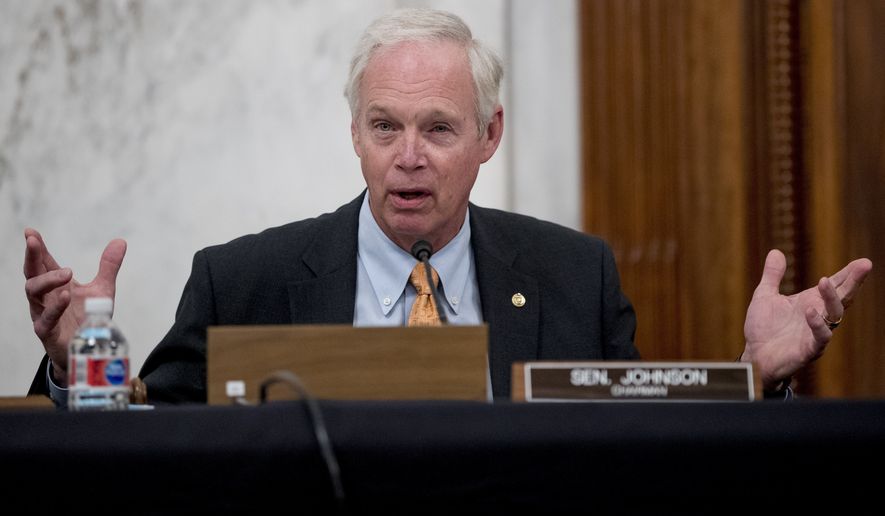
The Senate's fate rests in Trump's performance at the ballot box
by Michael McKennaANALYSIS/OPINION:
While much of America is watching the presidential race, most of the political class is watching the handful of Senate races that will determine which party presides over the Senate, and, consequently, how much of the next president’s agenda will have a chance at becoming reality.
The outcomes of a second term for President Trump or a first term for a Democratic president look radically different depending on which party holds the majority in the Senate.
Republicans currently hold 53 seats in the Senate, the Democrats hold 45, and there is one socialist and one independent, both of whom caucus with the Democrats. If Mr. Trump wins reelection, the Democrats will need to net four additional seats to achieve a voting majority in the Senate. If the eventual Democratic nominee becomes president, they need just three, keeping in mind that the vice president breaks ties in the Senate.
The Republicans seem likely, although not certain, to take a seat in Alabama from the Democrats. The Republican challenger in Michigan is impressive and has a chance against a disinteresting and disinterested Democratic Sen. Gary Peters. Senate seats held by Republicans in Arizona, Colorado, Montana, Maine and perhaps North Carolina and Iowa are at risk.
Structure, history and data can help us think about likely outcomes in this election cycle.
In an election dominated by sentiments about the incumbent, it is important to note that the fates of Senate candidates for some time have been tied to the performance of their party’s presidential candidates.
In the most recent five presidential election years (2000-2016), there have been 169 Senate races. In 145 of those races, the Senate candidate won when the party’s presidential candidate carried the state. In only 24 instances did a state vote for a senator and a presidential candidate from different parties. In 21 of those instances, Democrats won the Senate seat while the Republican nominee for president won the state.
Importantly for those running with Mr. Trump at the top of the ticket this year, the Republicans have managed to split a state just three times since 2000 — Judd Gregg in New Hampshire in 2004, Susan Collins in Maine in 2008, and Dean Heller in Nevada in 2012.
Interestingly, in 2016, no states split their vote. In 2012, just five states split, and just one of those winning senators received more votes than the Republican presidential candidate. Democratic Sen. Claire McCaskill in Missouri got 2,200 more votes than Mitt Romney, out of about 3 million cast.
In the previous three presidential election years (’08, ’04, ’00), 19 states split, and 15 winning Senate candidates outperformed the other side’s presidential nominee.
In short, outcomes in Senate elections held in presidential election years have been related to the performance of the top of the ticket for some time, and that process seems to be accelerating.
That suggests that Republicans running where Mr. Trump is in trouble may be in for a bumpy ride. It also suggests that in states where Mr. Trump is likely to do well — North Carolina, Iowa, and especially Montana (where Sen. Steve Daines is a star and will probably run close to Mr. Trump, who is currently ahead in the state by about 15 points) — Republican candidates may have fair winds and following seas.
One last complicating thought deserves notice. Sometimes it is not clear who leads who to victory. For example, in 2016, Sen. Ron Johnson’s exemplary campaign effort in Wisconsin probably made the difference with respect to Mr. Trump’s victory there. Mr. Johnson received 75,000 more votes than the president, out of about 3 million votes cast. On the other hand, in Pennsylvania, the president probably made the difference with respect to Sen. Pat Toomey. Mr. Trump received about 19,000 more votes than Mr. Toomey out of about 6 million cast.
The bottom line is that if the president wins, especially if he runs as expected in places such as North Carolina, Iowa and Maine, the Republicans probably will hold the Senate. If he does not, the Democrats may preside over a very narrowly divided Senate.
• Michael McKenna, a columnist for The Washington Times, is the president of MWR Strategies. He was most recently a deputy assistant to the president and deputy director of the Office of Legislative Affairs at the White House.